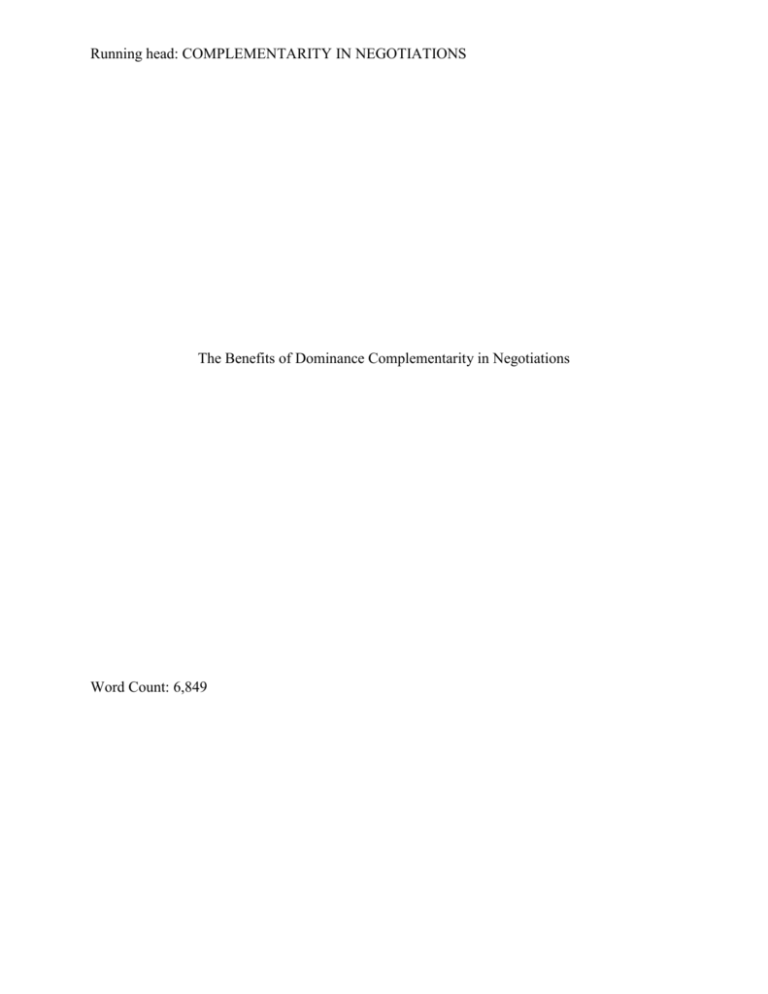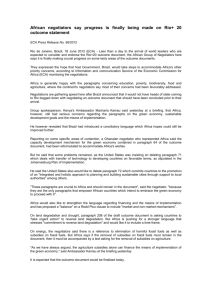The Benefits of Dominance Complementarity in Negotiations
advertisement

Running head: COMPLEMENTARITY IN NEGOTIATIONS The Benefits of Dominance Complementarity in Negotiations Word Count: 6,849 COMPLEMENTARITY IN NEGOTIATIONS ii ABSTRACT We investigated whether dominance complementarity can lead people to reach mutually beneficial outcomes in negotiations by increasing the likelihood that they will successfully coordinate the exchange of information. We suggest that negotiators who differ in how dominantly they behave in the negotiation exchange information effectively because they fulfill different roles in the negotiation process. Study 1 demonstrated that dominant negotiators generally assert their desires, while relatively submissive negotiators generally ask questions to find ways to satisfy their own desires without escalating conflict with the dominant negotiators. Studies 2 and 3 demonstrated that participants were best able to discover integrative agreements when one negotiator was instructed to behave dominantly and the other negotiator, submissively. Improved information exchange mediated the relationship between dominance complementarity and improved joint outcomes in Study 3. Keywords: Dominance, Complementarity, Negotiations, Coordination, Power COMPLEMENTARITY IN NEGOTIATIONS 1 The Benefits of Dominance Complementarity in Negotiations When negotiators act dominantly by raising their voices, moving themselves to physical positions associated with higher power, or expanding their body postures to make themselves appear larger, their moves may increase the portion of the “pie” that they receive (Bacharach & Lawler, 1981; Camras, 1984; Carnevale, Pruitt, & Seilheimer, 1981; Komorita & Brenner, 1968; Lewis & Fry, 1977). Because dominance behaviors can elicit stress and alienate the negotiation counterpart (Pruitt, 1983), scholars have counseled negotiators to reserve the use of such behaviors for competitive interactions with strangers (Neale & Bazerman, 1991; Valley, Neale & Mannix, 1995). Scholars have similarly counseled negotiators to refrain from behaving submissively except when doing so may help them to preserve their relationships and to avoid impasse (Anderson, Ames, & Gosling, 2008; Holtgraves & Yang, 1990, 1992). We argue that expressing dominance and submissiveness may have benefits beyond those previously identified and may therefore be useful in a wider variety of negotiation contexts. Basing our hypotheses on interpersonal circumplex theory (Carson, 1969; Kiesler, 1983; Wiggins, 1979), which organizes behavior along the two orthogonal dimensions of affiliation and control, we suggest that expressions of dominance and submissiveness can also help negotiating dyads create value by increasing the likelihood that they will successfully coordinate the exchange of information. We argue that enhanced value creation occurs when these expressions create the dynamic of dominance complementarity, characterized by one person in a dyadic interaction behaving dominantly and his/her counterpart behaving submissively (i.e., less dominantly). We hope not only to offer advice for people approaching negotiations, but also to describe how pairing of dominance and submissiveness can affect coordination in interdependent social COMPLEMENTARITY IN NEGOTIATIONS 2 tasks. We seek to contribute to interpersonal circumplex theory by demonstrating objective, material benefits to dominance complementarity and to cognitive negotiation theory (Neale & Bazerman, 1991) by showing that displaying dominance and submissiveness can enhance value creation. DOMINANCE AND SUBMISSIVENESS IN NEGOTIATIONS Dominance behaviors are verbal, nonverbal, or para-verbal (e.g., tone, cadence) communicative behaviors that negotiators consciously or unconsciously employ to influence others (Burgoon & Dunbar, 2000). Negotiators expressing dominance verbally lead the conversations by dictating topic changes and by expressing their preferences and positions freely and confidently (e.g., Burgoon, Johnson, & Koch, 1998; Weisfeld & Linkey, 1985). Nonverbal behaviors associated with dominance include expanding one’s body posture, using gestures often, reducing interpersonal distances, and speaking in a loud voice. Negotiators express submissiveness by making themselves physically compact, refraining from gesturing, maintaining interpersonal distances, and speaking in a soft voice. These behaviors are often accompanied by verbal behaviors, such as using language that is less assertive (Bradac & Mulac, 1984). Negotiators expressing submissiveness may express their preferences less directly and less forcefully than do negotiators expressing dominance. Submissiveness, which the literature on interpersonal circumplex theory uses as a label to denote traits ranging from docile and deferential to servile (e.g., Kiesler, 1983), should not be confused with passivity or yielding, defined as giving in to the other party’s preferences. Passivity conveys withdrawal from the interaction, whereas submissiveness connotes cooperation and agreeableness (Horowitz et al., 2006). People who use a submissive interactional style are not inactive, nor do they necessarily concede to others’ demands. They COMPLEMENTARITY IN NEGOTIATIONS 3 instead employ relatively soft persuasion tactics and influence their interaction partners while avoiding direct conflict with them (Hinkin & Schriesheim, 1990). Thus, when we refer to negotiators acting relatively submissively or less dominantly than their negotiation counterparts, we are describing the negotiators’ use of this interactional style, as defined by interpersonal circumplex theorists (e.g., Horowitz et al., 2006; Tiedens & Fragale, 2003), rather their willingness to concede to the other negotiator. Numerous studies have shown that negotiators who act dominantly are viewed as powerful (e.g., Burgoon & Dunbar, 2006; Pruitt, 1981) and, consequently, claim a larger share of the value to be claimed than do their counterparts (e.g., Carnevale et al., 1981; Weingart, Bazerman, Thompson, & Carroll, 1990). The few studies that have examined how dominance tactics affect value creation have generally shown that the use of strong pressure techniques (i.e., threats, positional commitments, and arguing) impairs value creation insofar as these behaviors are exhibited to make the negotiator look tough (e.g., Carnevale, Pruitt, & Britton, 1979; Lewis & Fry, 1977). This research offers valuable insights for negotiators; however, it has left unexplored the idea that relatively non-antagonistic displays of dominance and submissiveness, when paired together, may positively influence negotiators’ ability to coordinate their search for mutually-beneficial outcomes. THE INTERPERSONAL CIRCUMPLEX MODEL The Interpersonal Circumplex Model is a descriptive mapping of social behavior in a twodimensional space along the orthogonal dimensions of affiliation and dominance/control/agency (e.g., Carson, 1969). People generally assimilate on the affiliation dimension by behaving agreeably with those behaving agreeably toward them and by quarrelling with those quarrelling with them. Conversely, people contrast with others on the control dimension, behaving COMPLEMENTARITY IN NEGOTIATIONS 4 submissively toward others who behave dominantly and behaving dominantly toward others who behave submissively (Horowitz, Locke, Morse, Waikar, Dryer, Tarnow, & Ghannam, 1991; Horowitz, et al., 2006; Kiesler, 1983; Tiedens & Jimenez, 2003). Importantly, interpersonal circumplex theorists (e.g., Carson, 1969) use the term “dominance” to refer to a range of behaviors that range from being downright domineering to exhibiting an open body posture that communicates assertiveness, confidence, and powerfulness. People often think of dominant behaviors as hostile. Indeed, some theorists (e.g., Horowitz et al., 2006) replace the word “dominance” with “control” or “agency” when describing this dimension to avoid such unintended connotations. However, the dominance/control/agency dimension of behavior is nonetheless distinct from the warmth/communion dimension, and some dominant behaviors are classified as non-hostile, whereas others are classified as hostile (Orford, 1986). We focus our discussion on dominance behaviors that are assertive, agentic, and forceful – but not particularly antagonistic or intrinsically hostile. Interpersonal circumplex theorists have suggested and shown that pairing such dominance behaviors with submissiveness (“complementarity”) offers benefits for social interactions, such as people like one another more and feel more comfortable in their interactions when this dynamic occurs (Dryer & Horowitz, 1997; Estroff & Nowicki, 1992; Horowitz et al., 1991; Sadler & Woody, 2003; Tiedens & Fragale, 2003). Owing to the positive feelings generated by complementarity, people generally behave submissively toward others who behave dominantly and behave dominantly toward others who behave submissively (Carson, 1969; Horowitz, Locke, Morse, Waikar, Dryer, Tarnow, & Ghannam, 1991; Horowitz, et al., 2006; Kiesler, 1983; Tiedens & Fragale, 2001). As Horowitz et al. (2006) explain, expressions of dominance communicate a desire for agency or control and expressions of submissiveness COMPLEMENTARITY IN NEGOTIATIONS 5 communicate a desire for the interaction partner to take control. When an individual responds to dominance with dominance or to submissiveness with submissiveness, he/she frustrates the other’s motive, which leads to negative emotion. When an individual responds to dominance with submissiveness or to submissiveness with dominance, he/she allows the partner to satisfy the goal and thereby improves rapport. In contrast to the demonstrations of complementarity’s subjective benefits (Dryer & Horowitz, 1997; Estroff & Nowicki, 1992; Horowitz et al., 1991; Sadler & Woody, 2003; Tiedens & Fragale, 2003), no research has demonstrated that dominance complementarity can yield objective benefits stemming from coordination. Thus, while dominance complementarity may feel good we do not yet know if it actually improves coordination. Indeed, after finding no effect of dominance complementarity on performance in a Desert Survival Task (Lafferty & Eady, 1974), Dryer and Horowitz (1997) concluded, “Apparently, a complementarity between partners, although satisfying, may not necessarily facilitate a dyad’s productivity” (p. 599). Dominance complementarity may nonetheless facilitate performance on tasks requiring extensive coordination because complementarity creates a sense of hierarchy within a dyad or group (Tiedens, Chow, & Unzueta, 2007) and hierarchy as a relational form can help people efficiently coordinate activity (Weber, 2006; Leavitt, 2004; Michels, 1911/1915). Supporting this notion, de Kwaadsteniet and van Dijk (2010) showed that status differences (e.g., boss vs. intern) help people to coordinate their choices in coordination exercises. They showed that low-status individuals tailor their behavior to accommodate the likely behavior of high-status individuals and that this submissiveness improved coordination. Because people use dominance displays as status cues (e.g., Bales, 1950), coordination may similarly result when one person in the dyad uses dominance displays to establish that he/she is taking the conversational lead. Thus, COMPLEMENTARITY IN NEGOTIATIONS 6 conversational dynamics may be used also allow even equal-status dyads to achieve gains in coordination. We therefore posit that dominance complementarity may yield objective benefits in social tasks when those tasks require coordination. We argue that dominance complementarity should improve coordination because people acting dominantly and people acting submissively take complementary approaches to conversation. People expressing dominance are more expressive of their preferences and positions, more likely to lead conversations by dictating topic shifts, and more assertive in trying to influence others (for review see Burgoon et al., 1998). Their nonverbal behavior signals to the interaction partner that the individual is adopting and will continue to adopt a forceful conversational style. The counterpart of a dominant negotiator could respond to this dominance in a few ways. The counterpart could match dominance with dominance and reject the statements of the counterpart or simply counter with his own position or statements of preferences. In this case, stalemates can occur or negotiators may be forced into compromises on each issue. Alternatively, the counterpart could attempt to find ways to work around the dominant negotiator’s positional statements by asking questions and making proposals that would allow the dominant negotiator to satisfy some of his or her top priorities while also allowing the submissive counterpart to satisfy some of his top priorities. We suggest this latter, more submissive, approach may be an effective way to coordinate the search for mutually beneficial outcomes. This coordinative dynamic can be contrasted to the dynamic created by both negotiators expressing dominance or both negotiators expressing submissiveness. In the former case, interaction partners battle for control, making it difficult to work together. Although some of this COMPLEMENTARITY IN NEGOTIATIONS 7 behavior early in the negotiation may facilitate later problem-solving, consistent mutual contending generally impedes value creation (Morley & Stephenson, 1977; Pruitt, 1983). In the case of two submissive interaction partners, little gets accomplished because no direction is set, and value creation is difficult. We therefore propose that dyads that exhibit complementarity along the control dimension of behavior create more value than do dyads in which both negotiators behave dominantly. We further propose that dyads with instructions to exhibit complementarity along the control dimension of behavior create more value than do dyads in which both negotiators are instructed to behave submissively. Because expressing dominance often improves negotiators’ ability to claim value (e.g., Belkin, Kurtzberg, & Naquin, 2013; Carnevale & Pruitt, 1992), negotiators may be reluctant to respond to counterpart dominance with relative submissiveness. However, if negotiators employ a relatively submissive interpersonal style while continuing to pursue their own interests, they may share in the benefits attributable to increased value creation. We test in our studies whether the negotiator acting relatively submissively shares in the hypothesized objective benefits attributable to dominance complementarity. OVERVIEW OF STUDIES Our studies examine how the combination of dominant and submissive behaviors affects negotiators’ behavior and performance. We instructed participants in our studies to display both verbal and nonverbal behaviors that have been shown previously to signal either dominance or submissiveness (see Hall, Coats, & Le Beau, 2005). After using Study 1 to show that dominance is associated with strongly asserting positions/preferences and submissiveness is associated with asking questions, we test in Study 2 whether negotiators in dyads consisting of one dominant and one relatively submissive (or less dominant) negotiator create more value than do negotiators in COMPLEMENTARITY IN NEGOTIATIONS 8 dyads in which both parties behaved either dominantly or submissively. In Study 3 we test whether improved information exchange mediates the relationship between dominance complementarity and improved negotiation performance. STUDY 1 In Study 1 we aim to show that activating the concept of submissiveness leads negotiators to ask questions and that activating the concept of dominance leads negotiators to assert their positions and preferences. Method Ninety undergraduates (35% Female, Mage = 20.93, SD = 2.70) from a subject pool at a large, private university on the West Coast of the United States read instructions for the “Merging Companies Exercise”, a two-party, six-issue negotiation exercise (Wiltermuth & Neale, 2011) that they believed they would be completing later. They read that they would negotiate over six terms that affected the future of a combined company. Each issue contained five potential agreement positions, which represented different point levels. We told participants that the goal of negotiation was to maximize their own points. One issue was distributive in that a gain for one negotiator represented an equal loss for the negotiator’s counterpart. Another issue was congruent, such that both parties desired the same agreement position. The remaining issues were integrative, such that each issue was more important to one negotiator than the other and could therefore be combined to create value. Negotiators read that a neutral third party would decide the terms of the merger should they impasse, and that these terms would result in a number of points that would be moderately easy to achieve through negotiation. We randomly assigned negotiators to one of three conditions. We asked participants in the dominant condition to display the following behaviors as they negotiated: taking charge of the COMPLEMENTARITY IN NEGOTIATIONS 9 conversation, speaking in a loud voice, making sure their views are understood, interrupting others often, reducing interpersonal distances (i.e., standing or sitting close to the counterpart), and demonstrating bodily openness (keeping knees apart, stretching out legs, keeping elbows away from the body, preventing hands from touching, keeping legs uncrossed). We asked participants in the submissive condition to display the following behaviors: treating the counterpart respectfully, making the counterpart feel competent, agreeing with the counterpart whenever possible (without sacrificing your own goals), complimenting the counterpart, maintaining a compact physical space (keeping knees together, keeping elbows in toward the body, bringing hands together, crossing legs), maintaining interpersonal distances (i.e., standing or sitting a good distance from the counterpart), and speaking in a soft voice. Participants in the control condition did not receive behavioral instructions. We then asked participants to write how they would negotiate the details of the merger. We asked them to be as specific as possible, noting which behaviors they would exhibit at which points during the discussion. Participants used a seven-point continuous scale (1: not at all, 7: very much) to indicate how much they would engage in each of a number of ways during the negotiation. We created an index of information-seeking from three items (e.g., “ask your counterpart about his/her interests”; α = .72) and a four-item index of information-sharing (e.g., “make clear statements about your interests”; α = .67). Results and Discussion Table 1 displays means and standard deviations of key variables. We conducted one-way ANOVA analyses and contrasts to compare responses across the dominant, control, and submissive conditions. Consistent with predictions, negotiators in the dominant condition scored higher on the index of information sharing than did negotiators in the control (t(85) = 2.18, p = COMPLEMENTARITY IN NEGOTIATIONS 10 .03, d = 0.64) or submissive (t(85) = 2.37, p = .02, d = 0.61) conditions. Also as predicted, negotiators in the submissive condition scored higher on the index of information-seeking than did negotiators in the dominant condition, t(85) = 2.12, p = .04, d = 0.54. Their scores did not differ from those in the control condition, t(85) = 1.46, p = .15, d = 0.18. Negotiators in the submissive condition also indicated being more likely to think of ways to satisfy their counterparts’ interests while satisfying their own than did negotiators in the dominant condition, t(85) = 3.07, p = .003, d = 0.75. They did not significantly differ from negotiators in the control condition on this dimension, t(85) = 0.56, p = .58, d = 0.19. ----------------------------------------------Insert Table 1 about here -----------------------------------------------Two raters read the free response answers and indicated, using the same items used by participants, the extent to which the participants seemed to engage in information-sharing (α = .82) and information-seeking, α = .88. Negotiators in the dominant condition scored higher on information sharing than did negotiators in the submissive condition (t(72) = 3.16, p = .002, d = 0.65), while negotiators in the submissive condition scored higher on information seeking than did negotiators in the submissive condition, t(72) = 1.96, p = .054, d = 0.61. Study 1 therefore indicates that negotiators who are inclined to act dominantly plan to take different approaches to information exchange than do negotiators who are inclined to act submissively. STUDY 2 Study 2 tests whether dyads in which one negotiator behaved dominantly and one negotiator behaved submissively create more value than do dyads in which both negotiators behaved dominantly or both negotiators behaved submissively. COMPLEMENTARITY IN NEGOTIATIONS 11 Method Participants and experimental design. As part of class exercises, 198 undergraduates (50% female; Mage = 21) at five West Coast colleges participated in the experiment. The experimental design of the study included the between-dyad variable of the dyad’s dominance/submissiveness instructions (both submissive vs. complementary vs. both dominant), and the within-dyad variable of company represented (Tolliver vs. Radeco). The gender distribution did not differ across dyadic condition, χ2(4) = .22, p = .99. Procedure. Participants reviewed the preparation documents for the negotiation exercise used in Study 1. Dominance / submissiveness manipulation. Negotiators receiving the dominance instructions read: “Research has shown that displaying some behaviors can give negotiators the upper hand in a negotiation.” They then read that they should display the dominance behaviors detailed in the description of Study 1. Negotiators receiving the submissiveness instructions were told “Sometimes negotiators come on too strong and the result is that negotiators can lock horns. Research shows that negotiators need to display behaviors that convey that they are not going to attack the other and that the other does not need to fear them. That is, negotiators can be led astray by being too tough and forceful. In this negotiation try to disarm your counterpart by using behavior that conveys that you are not trying to dominate him or her.” They were then told to display the submissiveness behaviors listed in Study 1. Dependent variables. Joint points created by the dyad and points claimed by the individual negotiator served as the primary dependent measures. We also examined the number of points earned on congruent issues and integrative issues. After the negotiation, participants indicated how submissively and dominantly they and their counterparts behaved within the negotiation. COMPLEMENTARITY IN NEGOTIATIONS 12 We asked negotiators to indicate how dominantly they behaved and how submissively they behaved. Participants responded to these questions using seven-point continuous scales. To obtain a counterpart-generated measure of negotiator dominance, we presented negotiators with the list of dominance behaviors viewed by negotiators in the dominant condition. We asked them to circle the behaviors exhibited by their counterpart. We also asked “How many of the above behaviors did your counterpart exhibit in this negotiation?” We combined these scores into a behavioral count measure of dominance, α = .74. We followed the same procedure to create a behavioral count measure of submissiveness, α = .72. Results Treatment of data. We collapsed data across company role and school, as neither variable significantly interacted with behavioral instructions to affect negotiators’ points. We excluded four dyads for failing to follow the negotiation instructions, but also present the main results inclusive of these dyads. Across Studies 2 and 3, negotiators receiving dominance instructions were as likely to agree to deals worth less than their best alternative to a negotiated agreement as were negotiators receiving submissiveness instructions. We analyzed individual-level data in both studies using the mixed modeling technique advised by Kenny, Kashy and Cook (2006) because outcomes within dyads were interdependent, rs < -.20, ps < .01. Manipulation checks. Negotiators who had instructions to act dominantly reported that they acted more dominantly (M = 4.67, SD = 1.52) than did negotiators who had instructions to act submissively (M = 4.11, SD = 1.57); F(1,167.66) = 5.796, p = .017, d = .37. Similarly, negotiators who had instructions to act submissively reported that they acted more submissively (M = 4.87, SD = 1.28) than did negotiators who had instructions to act dominantly (M = 3.91, SD = 1.56); F(1,171.66) = 19.44, p < .001, d = .67. COMPLEMENTARITY IN NEGOTIATIONS 13 Negotiators instructed to behave dominantly scored somewhat higher on the behavioral count measure of dominance (M = 3.26, SD = 1.45) than did negotiators in the submissive condition, (M = 2.79, SD = 1.45), F(1,175.63) = 4.07, p = .045, d = .30. We found that the negotiators who had instructions to act submissively rated their counterparts higher on the behavioral count measure of negotiator submissiveness (M = 4.36, SD = 1.64) than did negotiators who had instructions to act dominantly, (M = 3.63, SD = 1.46); F(1,174.03) = 8.518, p = .004, d = .47. Unexpectedly, we did not find a significant effect of the negotiators’ own instructions on the behavioral count measure of submissiveness, (Mdom = 3.82, SD = 1.46 vs. Msub = 4.18, SD = 1.69), F(1,174.03) = 1.166, p = .282. Neither gender nor the interaction of gender and behavioral instructions significantly predicted self-ratings or counterpart counts of negotiator behavior, ps > .15. Negotiation outcomes. Figure 1 displays mean points obtained by negotiators. The FTest of the 1 x 3 Framing (both submissive vs. complementary vs. both dominant) one-way ANOVA on joint points was significant, F(2,88) = 5.19, p = .01. As predicted, when one negotiator was instructed to act dominantly and the other negotiator was instructed to act submissively the dyads created more joint points (M = 8,090, SD = 1,596) than did dyads in which both negotiators were instructed to act dominantly (M = 6,991, SD = 1,667; t(88) = 2.47, p = .02, d = .67) and dyads in which both negotiators were instructed to behave submissively (M = 6,911, SD = 1,846), t(88) = 2.83, p = .01, d = .68. There was no difference between dyads in which both negotiators acted dominantly and those in which both negotiators acted submissively, t(88) = 0.15, p = .89. We then examined whether negotiators in the complementary condition created more value than did negotiators in the other conditions because they did a better job of identifying the congruent issue, in which both sides wanted the same outcome, or because they COMPLEMENTARITY IN NEGOTIATIONS 14 were better identified possible tradeoffs on integrative issues. Condition did not affect the number of points that the negotiators earned on the congruent issue (F(2,88) = .987, p =.377), but it did affect the number of points earned from integrative issues, F(2,88) = 6.064, p =.003. Negotiators in the complementary condition earned more points from these issues (M = 11,886, SD = 1,507) than did dyads in which both negotiators were instructed to act dominantly (M = 10,617, SD = 1,612; t(88) = 3.10, p = .003, d = .81) and dyads in which both negotiators were instructed to behave submissively (M = 10,848, SD = 1,661), t(88) = 2.605, p = .011, d = .65. We repeated the main analysis including the four dyads in which negotiators did not follow instructions and accepted deals far below the minimum stated in their instructions. As predicted, when one negotiator was instructed to act dominantly and the other negotiator was instructed to act submissively the dyads created more joint points (M = 8,070, SD = 1,583) than did dyads in which both negotiators were instructed to act dominantly (M = 6,858, SD = 1,692; t(92) = 2.82, p = .006, d = .74) or dyads in which both negotiators were instructed to behave submissively (M = 6,857, SD = 1,834), t(92) = 2.92, p = .004, d = .71. We next examined value claiming within the complementary dyads. The dominance versus submissiveness manipulation did not affect the points the individual negotiators claimed, as dominant negotiators did not claim significantly more points (M = 4,105, SD = 1,253) than did their submissive counterparts in the complementary condition (M = 3,965, SD = 1,515), F(1,42) = 0.145, p = .745. Thus, gains to negotiators in the complementary condition came from expanding the amount of value available to the dyad rather than claiming a greater share of the value available. We then examined whether negotiators’ individual outcomes would be superior when they contrasted rather than matched their counterparts’ interpersonal style. To do so, we first COMPLEMENTARITY IN NEGOTIATIONS 15 conducted a 2 Dominance/Submissiveness Instructions (dominance instructions vs. submissiveness instructions) x 2 Counterpart Dominance/Submissiveness Instructions (dominance instructions vs. submissiveness instructions) mixed models analysis on points accumulated by individual negotiators. The main effects of instructions and counterpart instructions were not significant, p’s > .5. Reflecting the increased value creation, the instructions x counterpart instructions interaction was significant, F(1,92) = 14.8, p < .01. Negotiators behaving dominantly in the complementary (dominance vs. submissiveness) condition accumulated more value (M = 4,052, SD = 1,220) than did negotiators in the bothsubmissive condition (M = 3,456, SD = 1,407; t(94) = 2.18, p = .03, d = .45) or those in the bothdominant condition (M = 3,495, SD = 1,285), t(86) = 2.06, p = .04, d = .44. Negotiators behaving submissively in the complementary condition also accumulated more value (M = 4,038, SD = 1,455) than did negotiators in the both-submissive condition (t(94) = 1.98, p = .05, d = .41) and marginally more than those in the both-dominant condition, t(84) = 1.84, p = .07, d = .40. The results therefore showed a material benefit to behaving dominantly when facing a submissive counterpart and a benefit to behaving submissively when facing a dominant counterpart. ----------------------------------------------Insert Figure 1 about here -----------------------------------------------Discussion Dyads in which one negotiator behaved dominantly and one negotiator behaved relatively submissively created more value than did dyads in which both negotiators behaved either dominantly or submissively. Complementary dyads achieved these gains by better identifying mutually-beneficial tradeoffs on integrative issues. The gains from complementarity did not go COMPLEMENTARITY IN NEGOTIATIONS 16 solely to the dominant negotiator in the complementary dyads. Relatively submissive negotiators in the complementary condition accumulated significantly more value than did submissive negotiators facing other submissive negotiators and marginally more value than did dominant negotiators facing dominant negotiators. STUDY 3 Study 1’s results suggest that negotiators behaving dominantly and those behaving submissively fulfill different functions in the information exchange process. The dominant negotiator assertively puts forward information about her positions and preferences. The relatively submissive member attends to that information, questioning the dominant negotiator so that he may achieve satisfactory outcomes on his top priorities while accommodating the preferences of the dominant negotiator on her top priorities. We hypothesize that this questioning by the submissive negotiator may illuminate the differences in priorities that the two negotiators place on issues. The resulting increase in the amount of information exchanged about priorities should, in turn, improve negotiators’ ability to create value within negotiations (Thompson & Hastie, 1990). Because Study 2 left open the possibility that negotiators would be better able to create value if they were to refrain from acting dominantly or submissively altogether, we also compared the performance of dyads in the complementary condition with dyads in which neither negotiator received dominance or submissiveness instructions. We hypothesize that dyads who are instructed to exhibit dominance complementarity create more value than do dyads with no behavioral instructions. Additionally, we propose that improved information exchange mediates the relationship between dominance complementarity and improved value creation. Method COMPLEMENTARITY IN NEGOTIATIONS 17 Participants and experimental design. In exchange for payment of ten dollars, 226 (49% female, Mage = 22.0) students at a West Coast university participated in the exercise. The design of the study included the between-dyad variables of behavioral instructions (control with no instructions to pay attention to the counterpart vs. control with instructions to pay heightened attention to the counterpart vs. complementarity) and the within-dyad variable of role (recruiter vs. candidate). Procedure. Participants engaged in the “New Recruit Exercise” (Pinkley, Neale, & Bennett, 1994), which is similar in structure to the exercise used in Studies 1 and 2. Participants completed a short post-negotiation questionnaire. Behavioral instructions manipulation. Participants were randomly assigned to the control condition, the heightened attention condition, or the complementarity condition. Negotiators in half of the control condition dyads received no behavioral instructions, while negotiators in the heightened attention condition dyads were instructed “research suggests that paying close attention to your counterpart’s words and actions can dramatically enhance your negotiation performance. Thus, your negotiation strategy should include monitoring the behavior of your counterpart.” We included this heightened attention condition to ensure that increased attention paid to the counterpart in the complementarity condition did not lead participants in those conditions to outperform participants in the control condition. We also advised participants in the complementarity condition that paying close attention to their counterparts can improve negotiator performance. Negotiators given behavioral instructions were told that successful negotiators recommend that you should display certain behaviors within a negotiation to get a better deal. Negotiators receiving instructions to act dominantly (submissively) saw the same list of nonverbal behaviors COMPLEMENTARITY IN NEGOTIATIONS 18 signaling dominance (submissiveness) that was used in Study 2. We omitted the Study 2 instructions that informed participants that negotiators can sometimes come on too strong and lock horns. One negotiator in each of the dyads in the complementarity condition received dominance instructions and one negotiator in each of these dyads received submissiveness instructions. We counterbalanced role and behavioral instructions. Dependent Variables. Participants indicated whether the dominant behaviors or submissive behaviors better characterized their behavior using a scale that ranged from 1 (More like Set B) to 7 (More like Set A). Dominant behaviors comprised Set A, while submissive behaviors comprised Set B. Participants were also asked to describe any instructions they may have been given about how to behave. Joint points created by the dyad served as the primary dependent measure. We also examined the points claimed by the individual negotiators. Additionally, as a measure of information exchange, participants indicated, using a seven-point Likert scale, how much information their counterpart revealed about the issues that were important or unimportant to him or her. Results Treatment of data. Twelve of the original dyads included a negotiator who failed to follow the negotiation instructions by accepting deals that were worth less than their alternatives to a negotiated settlement. We asked a number of these negotiators why they accepted deals that were worth less than their alternatives to a negotiated agreement and learned that the participants did not read the instructions about their alternative. Excluding these dyads, which were spread across conditions, did not change the pattern of the results. We present all results exclusive of these dyads. We supplement the presentation of these results by also presenting the main results (i.e., COMPLEMENTARITY IN NEGOTIATIONS 19 total value created by the negotiating dyad) inclusive of these dyads. Negotiator role had no main effect, nor did it interact with either dominance instructions or submissiveness instructions to predict negotiator points, ps > .35. We therefore combined across roles. Manipulation checks. Participants receiving instructions to act dominantly indicated behaving significantly more so than did participants who received instructions to act relatively submissively, t(186) = 3.18, p = .002, d = .84. Men reported behaving more dominantly (M = 4.06, SD = 1.65) than did women (M = 3.41, SD = 1.44), F(1, 178.2) = 9.22, p = .003). Gender did not interact with behavioral instructions to predict rated dominance, ps > .15. Negotiation outcomes. Table 2 displays negotiator points by condition and instructions. As expected, dyads in the complementarity condition created deals worth significantly more points than did those in the control conditions1, t(98) = 1.99, p = .05, d = .44. Negotiators behaving dominantly in the complementarity condition did not earn significantly more points (M = 5,606, SD = 2,236), than did negotiators behaving submissively in the complementary condition, (M = 5,558, SD = 2,024), F(1,63.05) = 0.014, p = .907. Dominant and submissive negotiators therefore shared in the additional value created as a result of dominance complementarity. The gender of the participant or the counterpart did not significantly interact with dominance or submissiveness instructions to predict negotiator points. We examined whether negotiators in the complementary condition created more value than did negotiators in the control conditions because they did a better job of identifying the congruent issue or by identifying possible tradeoffs on integrative issues. Condition did not affect the number of points that the negotiators earned on the congruent issue (t(95) = .949, p 1 There was no difference in the joint outcomes attained by control condition dyads instructed to pay heightened attention to their counterparts and those not given those instructions, p > .95. We therefore combined these groups into a single control condition. COMPLEMENTARITY IN NEGOTIATIONS 20 =.345), but it did affect the number of points earned from integrative issues, t(95) =2.175, p =.032, d = .50. Negotiators in the complementary condition earned more points from these issues (M = 12,655, SD = 1,285) than did dyads in which both negotiators were instructed to act dominantly (M = 11,784, SD = 2,101). Including the dyads in which at least one member of the dyad did not follow instructions did not change the pattern of results. Dyads in the complementarity condition created deals worth significantly more points (M = 10,897, SD = 1,836) than did those in the control conditions, (M = 10,120, SD = 2,074); t(110) = 1.94, p = .055, d = .40. ----------------------------------------------Insert Table 2 about here -----------------------------------------------Information exchange. Consistent with predictions, negotiators in the complementarity condition reported sharing significantly more information than did negotiators in the control condition, t(74.3)2 = 2.06, p = .04, d = .43. Negotiators receiving dominance instructions did not share significantly more information about their priorities than did negotiators who did not receive instructions to behave dominantly, t(65) = 0.82, p = .23. We tested if the increased information exchange in the complementarity condition dyads mediated the relationship between complementarity and improved joint outcomes. Relative to negotiators in the control condition, negotiators in the complementarity condition were rated by their counterparts as sharing more information about which issues were important/unimportant to them, B = .42, SE = .22, t(96) = 1.95, p = .05. Further, rated sharing of information was associated with improved joint outcomes, B = 420.6, SE = 189.5, t(96) = 2.22, p = .03. The 2 Levene’s test of equality of variances was significant, F = 4.53, p = .04. We therefore used the corrected t-test. COMPLEMENTARITY IN NEGOTIATIONS 21 previously significant effect of complementarity on joint outcomes (B = 809.1, SE = 407.0, t(96) = 1.99, p = .05) became non-significant when we controlled for the amount of information negotiators shared, B = 633.8, SE = 406.7, t(96) = 1.56, p = .12. A bootstrap analysis revealed that the 99% bias-corrected confidence intervals for the size of the indirect effect excluded zero (1.32, 595.9), which suggested a significant indirect effect (MacKinnon, Fairchild, & Fritz, 2007; Preacher & Hayes, 2004). Information exchange therefore mediated the relationship between complementarity and improved joint outcomes. Discussion Increased information exchange mediated the relationship between complementarity and improved joint outcomes. As in Study 3, the gains came from negotiators’ ability to identify potential tradeoffs on integrative issues. The additional value created was shared by dominant and relatively submissive negotiators. The study supports the idea that complementarity achieves its benefits through improved information exchange attributable to dominant and submissive negotiators fulfilling different roles in the conversational process. One limitation of the study is that information exchange was measured using a single item. Future research could use multiitem measures of information exchange to obtain greater insight into how dominance complementarity operates through increased information exchange to improve joint outcomes. GENERAL DISCUSSION Our studies show that the dynamic of dominance complementarity can improve coordination and thereby yield objective benefits. Negotiating dyads created the most value when one negotiator received instructions to act dominantly and the other negotiator received behavioral instructions to act less dominantly. The studies provide preliminary evidence that the heightened information exchange that results from negotiators taking complementary approaches COMPLEMENTARITY IN NEGOTIATIONS 22 to conversation drives the increases in value creation. The studies also indicate that both the dominant and the submissive negotiator within a dyad may benefit from dominance complementarity. Areas for Future Research Our results may stem from the forms of dominance and submissiveness that the participants were instructed to use. These were relatively non-antagonistic dominance cues, which may have contributed to their effectiveness. More antagonistic displays of dominance (e.g., threats) have been shown to impair value creation (e.g., Allred, Mallozzi, Matsui, and Raia, 1997; Carnevale et al., 1979). Future research could explore which types of dominance are most useful in the value-creation process. Although our sample size of more than 400 negotiators was large enough to detect that dominance complementarity can have a positive effect of negotiation outcomes, it was not large enough to study systematically which forms of dominance are most effective. Our research left unexamined the question of which specific dominance behaviors influenced the degree of value creation and which dominance behavior simply co-occurred with the behaviors that truly influenced value creation. As one reviewer pointed out, it is possible that the body language manipulations contributed little to value creation and that the instructions related to verbal behavior had the bulk of the impact. Similarly, future work could explore the types of submissiveness that are most effective. The type of submissiveness we asked people to display was not a passive, yielding style of submissiveness; rather, it was a less combative approach to achieving their own goals within the negotiation. The observed patterns may not generalize to all forms of dominant and submissive behaviors. Work on the boundary conditions of this effect are therefore needed, as is more concrete evidence confirming Mannix and Neale’s (1993) theory and our suggestion that the COMPLEMENTARITY IN NEGOTIATIONS 23 submissive negotiator is performing the mental work of assembling the information offered by dominant/powerful negotiators with their own information. Our studies only suggest and provide no direct empirical evidence that the submissive negotiator is making multi-issue offers as theorized. Another limitation of the current study is that we do not have direct evidence that hierarchy is created within the complementary dyads. Future research should examine whether negotiators’ sense of power are affected by acting dominantly or submissively in a negotiation and how those power dynamics carry over to negotiators’ relationships following the negotiation. Future research may also productively examine why the forms of dominance and submissiveness displayed in our studies did not yield differences in the percentage of value claimed by each negotiator. Past research (e.g., Edinger & Patterson, 1993) has consistently shown that dominance increases persuasiveness, so the lack of differences in amount of value claimed was unexpected. We speculate that the relatively non-antagonistic nature of the dominance behavior displayed may have attenuated any differences in the percentage of value claimed between negotiators. Recent work (Sinaceur, Adam, Van Kleef, & Galinsky, 2013) showing that emotional inconsistency enables people to extract concessions from negotiating counterparts suggests that variability in communication style can yield benefits and affect negotiator behavior. Along these lines, future research could investigate whether negotiators who vacillate between behaving dominantly and submissively are more effective than those who adopt a consistent behavioral style. Future research could also productively explore the interaction of dominance and power. In unpublished work, Mastop (2012) has shown that people tend to mimic the posture of low- COMPLEMENTARITY IN NEGOTIATIONS 24 status interaction partners but complement the posture of high-status interaction partners, particularly when those high-status interaction partners exhibit dominance. Dominance complementarity may therefore not be likely to result from a low-status member of a negotiating dyad displaying dominance. Indeed, dominance may be construed negatively, seen as inappropriate, and elicit reciprocal dominance when expressed by the lower power member of a dyad. It would also be interesting to explore whether complementarity is more or less effective in facilitating the creation of value in cultures with large power distances (Hofstede, 2001). Finally, future work could investigate whether all tasks would benefit from dominance complementarity. It is entirely possible that either mutual dominance or mutual submissiveness would be more effective than dominance complementarity for some types of tasks. For example, when people must brainstorm ideas, it may be advisable for both parties to behave dominantly. CONCLUSION Although dominance behaviors have largely been cast as value-claiming moves best reserved for competitive interactions with strangers (Neale & Bazerman, 1991; Valley et al., 1995), our studies suggest that expressions of dominance and submissiveness can facilitate value creation by enabling negotiators to coordinate the exchange of information within social interactions more effectively. Our findings therefore contribute to theory by linking the control dimension of interpersonal behavior with people’s abilities to discover sources of mutual benefit within social interactions. Moreover, our findings suggest that the time and place for expressing dominance and submissiveness may extend beyond competitive interactions with strangers. COMPLEMENTARITY IN NEGOTIATIONS 25 REFERENCES Allred, K. G., Mallozzi, J. S., Matsui, F., & Raia, C. P. (1997). The influence of anger and compassion on negotiation performance. Organizational Behavior and Human Decision Processes, 70, 175–187. doi:10.1006/obhd.1997.2705 Anderson, C., Ames, D. R., & S. D. Gosling, S. D. (2008). Punishing hubris: The perils of overestimating one's status in a group. Personality and Social Psychology Bulletin, 34: 90-101. doi: 10.1177/0146167207307489 Bacharach, S. B., & Lawler, E. J. (1981). Bargaining: Power, tactics and outcomes. San Francisco, CA: Jossey-Bass. ISBN-0-87589-498-4 Bales, R.F. (1950) Interaction process analysis - A method for the study of small groups, Cambridge, Mass: Addison-Wesley Press. Belkin, L. Y., Kurtzberg, T. R., & Naquin, C. E. (2013). Signaling dominance in online negotiations: The role of affective tone. Negotiation and Conflict Management Research, 6(4), 285-304. DOI: 10.1111/ncmr.12016 Bradac, J. J., & Mulac, A. (1984). A molecular view of powerful and powerless speech styles. Communication Monographs, 51, 307–319. 0363-7751 Burgoon, J. K., & Dunbar, N. E. (2000). Interpersonal dominance as a situationally, interactionally, and relationally contingent social skill. Communication Monographs, 67, 96-121. DOI: 10.1080/03637750009376497 Burgoon, J. K., & Dunbar, N. E. (2006). Nonverbal expressions of dominance and power in human relationships. Manusov, Valerie; Patterson, Miles L. The Sage handbook of nonverbal communication. (pp. 279-297). Thousand Oaks, CA, US: Sage Publications, Inc. xxvii, 587 pp. COMPLEMENTARITY IN NEGOTIATIONS 26 Burgoon, J. K., Johnson, M. L., & Koch, P. T. (1998). The nature and measurement of interpersonal dominance. Communication Monographs, 65, 308–335. DOI: 10.1080/03637759809376456 Camras, L.A. (1984). Children’s verbal and nonverbal communication in a conflict situation. Ethology and Sociobiology, 5, 257-268. doi:10.1016/0162-3095(84)90005-0 Carnevale, P. J., & Pruitt, D. G. (1992). Negotiation and mediation. Annual Review of Psychology, 43, 531-582. Carnevale, P. J. D., Pruitt, D. G., & Britton, S. D. (1979). Looking tough: The negotiator under constituent surveillance. Personality and Social Psychology Bulletin, 5, 118-121. Carnevale, P.J., Pruitt, D.G., & Seilheimer, S. (1981). Looking and competing: Accountability and visual access in integrative bargaining. Journal of Personality and Social Psychology, 40, 111-120. doi: 10.1177/014616727900500126 Carson, R. C. (1969). Interaction concepts of personality. Chicago: Aldine. de Kwaadsteniet, E.W., & van Dijk, E. (2010). Social status as a cue for tacit coordination. Journal of Experimental Social Psychology, 46, 515-524. doi:10.1016/j.jesp.2010.01.005 Dryer, D.C., & Horowitz, L.M. (1997). When do opposites attract? Interpersonal complementarity versus similarity. Journal of Personality and Social Psychology, 72, 592-603. doi: 10.1037/0022-3514.72.3.592 Edinger, J. A., & Patterson, M. L. (1983). Nonverbal involvement and social control. Psychological Bulletin, 93, 30–56. Estroff, S. D., & Nowicki, S. (1992). Interpersonal complementarity, gender of interactants, and performance on word puzzles. Personality and Social Psychology Bulletin, 18, 351-356. COMPLEMENTARITY IN NEGOTIATIONS 27 doi: 10.1177/0146167292183012 Hall, J. A., Coats, E. J. & Le Beau, L. S. (2005). Nonverbal behavior and the vertical dimension of social relations: A meta-analysis. Psychological Bulletin, 131 (6), 898-924. doi: 10.1037/0033-2909.131.6.898 Hinkin, T. R., & Schriesheim, C. A. (1990). Relationships between subordinate perceptions of supervisor influence tactics and attributed bases of supervisory power. Human Relations, 43, 221-237. doi: 10.1177/001872679004300302 Hofstede, G. (2001). Culture's Consequences: comparing values, behaviors, institutions, and organizations across nations (2nd ed.). Thousand Oaks, CA: SAGE Publications. Holtgraves, T., & Yang, J. (1990). Politeness as universal: Cross-cultural perceptions of request strategies and inferences based on their use. Journal of Personality and Social Psychology, 59(4): 719-729. doi: 10.1037/0022-3514.59.4.719 Holtgraves, T., & Yang, J. (1992). Interpersonal underpinnings of request strategies: General principles and differences due to culture and gender. Journal of Personality and Social Psychology, 62(2), 246-256. doi: 10.1037/0022-3514.62.2.246 Horowitz, L. M., Locke, K. D., Morse, M. B., Waikar, S. V., Dryer, D. C., Tarnow, E. & Ghannam, J. (1991). Self-derogations and the interpersonal theory. Journal of Personality and Social Psychology, 61, 68-79. doi: 10.1037/0022-3514.61.1.68 Horowitz, L.M., Wilson, K.R., Turan, B. Zolotsev, P., Constantino, M.J. & Henderson, L. (2006). How interpersonal motives clarify the meaning of interpersonal behavior: A revised circumplex model. Personality and Social Psychology Review, 10, 67-86. doi: 10.1207/s15327957pspr1001_4 Kenny, D.A, Kashy, D.A., & Cook, W.L. (2006). Dyadic Data Analysis. New York: Guilford COMPLEMENTARITY IN NEGOTIATIONS 28 Publications. Komorita, S. S., & Brenner, A. (1968). Bargaining and Concession Making Under Bilateral Monopoly. Journal of Personality and Social Psychology, 9(1), 15-20. doi: 10.1037/h0025700 Kiesler, D. J. (1983). The 1982 interpersonal circle: A taxonomy for complementarity in human transactions. Psychological Review, 90, 185-214. Ddi: 10.1037/0033-295X.90.3.185 Lafferty, J., & Eady, P. (1974). The Desert Survival Problem. Plymouth, MI: Experimental Learning Methods. Leavitt, H.J. (2004). Top Down: Why Hierarchies Are Here to Stay and How to Manage Them More Effectively. Harvard Business School Press. Lewis, S., & Fry, W. (1977). Effects of visual access and orientation on the discovery of integrative bargaining alternatives. Organizational Behavior and Human Performance, 20, 75-92. doi:10.1016/0030-5073(77)90045-9 MacKinnon, D. P., Fairchild, A. J., & Fritz, M. S. (2007). Mediation analysis. Annual Review of Psychology, 58, 593-614. doi: 10.1146/annurev.psych.58.110405.085542 Mastop, E. A. (2012). On postural reactions: contextual effects on perceptions of and reactions to postures (Doctoral dissertation, Department Social & Organizational Psychology, Faculty of Social and Behavioural Sciences, Leiden University). Michels, R. (1911/1915). Political Parties: A Sociological Study of the Oligarchical Tendencies of Modern Democracy. Translated into English by Eden Paul and Cedar Paul. New York: The Free Press. From the 1911 German source. Morley I. E., & Stephenson, J. M. (1977). The social psychology of bargaining. London: Allen & Unwin. COMPLEMENTARITY IN NEGOTIATIONS 29 Neale, M. A., & Bazerman, M. H. (1991). Rationality and cognition in negotiation. New York: Free Press. Overbeck, J. R., Neale, M. A., & Govan, C. L. (2010). I feel, therefore you act: Intrapersonal and interpersonal effects of emotion on negotiation as a function of social power. Organizational Behavior and Human Decision Processes, 112(2), 126-139. doi:10.1016/j.obhdp.2010.02.004 Pinkley, R. L., Neale, M. A., & Bennett, R. J. (1994). The impact of alternatives to settlement in dyadic negotiation. Organizational Behavior and Human Decision Processes, 57, 97116. doi:10.1006/obhd.1994.1006 Preacher, K. J., & Hayes, A. F. (2004). SPSS and SAS procedures for estimating indirect effects in simple mediation models. Behavior Research Methods, Instruments, and Computers, 36, 717-731. doi:10.3758/BF03206553 Pruitt, D. G. (1981). Negotiation behavior. New York: Academic Press. Pruitt, D. G. (1983). Strategic choice in negotiation. American Behavioral Scientist, 27 ( 2) 167194. doi: 10.1177/000276483027002005 Sadler, P., & Woody, E. (2003). Is who you are who you’re talking to? Interpersonal style and complementarity in mixed-sex interaction. Journal of Personality and Social Psychology, 84, 80–96. 10.1037/0022-3514.84.1.80 Sinaceur, M., Adam, H., Van Kleef, G. A., & Galinsky, A. D. (2013). The advantages of being unpredictable: How emotional inconsistency extracts concessions in negotiation. Journal of Experimental Social Psychology, 49(3), 498-508. doi:10.1016/j.jesp.2013.01.007 Thompson, L., & Hastie, R. (1990). Social perception and negotiation. Organizational Behavior and Human Decision Processes, 47, 98-123. doi:10.1016/0749-5978(90)90048-E COMPLEMENTARITY IN NEGOTIATIONS 30 Tiedens, L. Z., Chow, R. M., & Unzueta, M. M. (2007). Complementary contrast and assimilation: Interpersonal theory and the social function of contrast and assimilation effects. In D. Stapel & J. Suls (Eds.), The Social Psychology of Contrast and Assimilation. New York, NY: Psychology Press. Tiedens, L. Z., & Fragale, A. R. (2003). Power moves: Complementarity in dominant and submissive nonverbal behavior. Journal of Personality and Social Psychology, 84, 558568. doi: 10.1037/0022-3514.84.3.558 Tiedens, L. Z., & Jimenez, M. C. (2003). Assimilation for affiliation and contrast for control: Complementary relationship schemas and complementary self-construals. Journal of Personality and Social Psychology, 85, 1049-1061. doi: 10.1037/0022-3514.85.6.1049 Valley, K. L., Neale, M. A., & Mannix, E. A. (1995). Friends, lovers, colleagues, strangers: The effects of relationships on the process and outcome of dyadic negotiations. Research on Negotiation in Organizations, 5, 65-93. Weber, R.A. (2006). Managing growth to achieve efficient coordination in large groups, American Economic Review, 96 (1), 114-126. doi: 10.1257/000282806776157588 Weingart, L. R., Bazerman, M. H., Thompson, L. L., & Carroll, J. S. (1990). Tactical behavior and negotiation outcomes. International Journal of Conflict Management, 1, 7–31. doi: 10.1108/eb022670 Weisfeld, G. E., & Linkey, H. E. (1985). Dominance displays as indicators of a social success motive. In S. L. Ellyson, & J. F. Dovidio (Eds.), Power, dominance, and nonverbal behavior (pp. 109–128). New York: Springer-Verlag. Wiggins, J.S. (1979). A psychological taxonomy of trait-descriptive terms: The interpersonal domain. Journal of Personality and Social Psychology, 37, 395-412. 10.1037/0022- COMPLEMENTARITY IN NEGOTIATIONS 3514.37.3.395 Wiltermuth, S. S., & Neale, M. A. (2011). Too much information: The perils of nondiagnostic information in negotiation. Journal of Applied Psychology, 96, 192-201. doi: 10.1037/a0021871 31 COMPLEMENTARITY IN NEGOTIATIONS 32 Table 1: Study 1 Means with 95% Confidence Intervals Independent Raters' Assessment Condition Dominant Control Submissive Information Sharing 5.92 [5.44, 6.40] 4.85 [4.21, 5.49] 4.85 [4.42, 5.79] Information Seeking 2.24 [1.57 ,2.92] 3.79 [3.02, 4.56] 3.28 [2.53, 5.03] Participants' Own Assessment Think of ways Information Information to satisfy both Sharing Seeking sets of interests 5.01 [4.64, 5.38] 4.57 [4.03, 5.12] 4.66 [3.92, 5.39] 4.36 [3.96, 4.76] 5.07 [4.60, 5.53] 5.64 [5.15 , 6.14] 4.31 [3.81, 4.80] 5.29 [4.84, 5.74] 5.87 [5.41, 6.32] Table 2: Key Study 3 Means with 95% Confidence Intervals Condition Control Condition Dyads 66 Total Points 10,355 [9,855, 10,854] Complementary Dominant Submissive Average 33 11,164 [10,586, 11,741] Info. About Priorities Revealed Self-Reported Behavioral Dominance 5,191 [4,910, 5,474] 4.53 [4.28, 4.79] 3.76 [3.49, 4.02] 5,606 [4,840, 6,399] 4.97 [4.44, 5.43] 4.10 [3.49, 4.71] 5,558 [4,840, 6,275] 4.97 [4.45, 5.40] 2.81 [2.35, 3.27] 5,582 [5,008, 6,078] 4.97 [4.63, 5.31] 3.44 [3.04, 3.85] Negotiator Points COMPLEMENTARITY IN NEGOTIATIONS 33 Figure 1: Study 2 negotiator points by negotiator and counterpart instructions 5,000 Counterpart Instructions 4,000 Submissive Dominant 3,000 2,000 Submissive Negotiator Instructions Dominant







